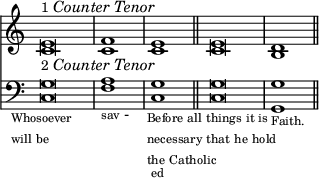Christ Church Tune.

Clifford's third specimen is quoted as 'Canterbury Tune,' and is that set to the Quicunque vult (Athanasian Creed) in Tallis's 'Cathedral Service'; but, as before, with harmonies differently arranged.
Canterbury Tune.

It has all the characteristics of the 8th Gregorian Tone, with just such variations as might be expected to occur from the lapse of time, and decay of the study of the ancient forms and rules of Church music.
The fourth of Clifford's examples is also a very good instance of the identity, in all essential characteristics, of the modern Anglican chant and the ancient Gregorian psalm tones. It is an adaptation of the 8th Tone, 1st ending—the tone being in the Tenor:—
The Imperial Tune.

The work published in 1661 by Edward Lowe, entitled 'Short Directions for the Performance of Cathedral Service' (2nd ed., 1664), also gives the whole of the tones, and nearly all their endings, according to the Roman Antiphonarium, and as Lowe had sung them before the Rebellion when a chorister at Salisbury. He also gives the harmonies quoted above as the 'Imperial' and 'Canterbury' tunes, and another harmony of the 8th Tone, short ending (Marbeck's 'Venite') with the plainsong in the bass.
The 'Introduction to the Skill of Music,' by John Playford (born 1613 [App. p.584 "1623"]), in its directions for the 'Order of Performing the Divine Service in Cathedrals and Collegiate Chapels' confirms the above statements. Playford gives seven specimens of psalm tones, one for each day of the week, with 'Canterbury' and the 'Imperial' tunes in 'four parts, proper for Choirs to sing the Psalms, Te Deum, Benedictus, or Jubilate, to the organ.'
The Rev. Canon Jebb, in the second volume of his 'Collection of Choral Uses of the Churches of England and Ireland' (Preface, p. 10), gives from the three writers quoted and from Morley's 'Introduction' (1597) a table of such old English chants as are evidently based upon or identical with the Gregorian psalm tones.
It is interesting to note also that in the earliest days of the Reformation on the Continent, books of music for the service of the Reformed Church were published, containing much that was founded directly upon the Gregorian plainsong; and it was chiefly through the rage for turning everything into metre that the chant proper fell into disuse among Protestant communities on the Continent. See the 'Neu Leipziger Gesangbuch' of Vopelius (Leipzig 1682).
The special work for the guidance of the clergy of the Roman Church, and all members of canonical choirs, in the plainsong which they have specially to chant, is called the Directorium Chori. The present Directorium corresponds to the famous work prepared by Guidetti (1582), with the aid of his master Palestrina. But as is the case in most matters of widespread traditional usance, differences are found between the books of present and past liturgical music, not simply in different countries and centuries, but in different dioceses of the same country and the same century. The York, Hereford, Bangor, and Lincoln 'uses' are named in our Prayer Book, as is also that of Salisbury, which obtained a foremost place of honour for the excellence of its church chant. Our own chants for the responses after the Creed, in the matins and vespers of English cathedrals, are the same to the present day with those found in the most ancient Sarum Antiphonary, and differ slightly from the Roman.
The psalm tone, or chant, in its original and complete form, consists of (1) An Intonation at the beginning, followed by a recitation on the dominant of its particular mode; (2) A Mediation, a tempo, closing with the middle of each verse; (3) Another recitation upon the dominant with a Termination completing the verse, as in the following—the Third Tone:—

In the modern Anglican chants the Intonation has been discarded, and the chant consists of the Mediation and Termination only.
When the tune or phrase coincides with a single verse of the psalm or canticle it is styled a 'single chant,' as are all those hitherto cited. At the time of the Restoration, as already stated, the Gregorian chants were still commonly used, till lighter tastes in music and the lessened numbers of men in cathedral choirs led to the composition of new treble chants and a rage for variety. Some of these, which bear such names as Farrant, Blow, and Croft, are fine and appropriate compositions. But a different feeling
